The 16th Media Art Biennale WRO began on 13th May. Over 250 artists from around the world presented their works in 10 venues across Wrocław; from the National Museum to Renoma department store. The first five days constituted the festival’s key events, including exhibitions, film screenings, conferences, performances and competitions – among others the First Best Media Art Diploma Work Competition, The Critics and Editors of Art Magazines Award. In this year’s edition of WRO, three prominent aspects could be distinguished: focus on young creators, technological innovation of works along with interaction with the audience, and search for new strategies to showcase art within a given space. This last aspect was of particular importance as ‘Testing exposure’ was the leitmotif of the festival.
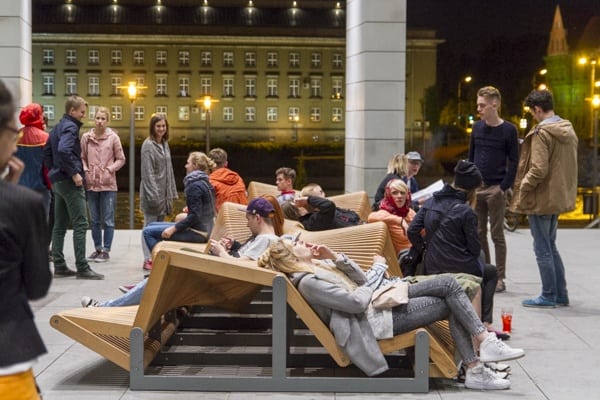
The 16th Media Art Biennale WRO, ‘Test Exposure’, outside the New Building of Wrocław University Library, photo Contemporary Lynx, Wrocław, 2015
Nature, technology and art
Works classified as new media art are characterised by, inter alia, the fact that numerous creators from various fields cooperate to complete them – a sound engineer, an artist, a software developer, or even such unusual collaborators as… ants.
The latter were part of a bioart project entitled ‘Symbiosity of Creation’ by a Polish artist Elvin Flamingo (also known as Jarosław Czarnecki). The work was exhibited in the WRO Art Centre. On the second floor, the room was in semi-darkness and to the left of the entrance there were five shiny cubes resembling television boxes. They were futuristic incubators designed by the artist, in which armies of ants walk around freely building their empire. They live in glass flasks, retorts, test tubes and pipes – the scenery recalls scenes taken from the Matrix movie. The first box ‘Kingdom of the Shared Quotidian’ is where weaver ants, aggressive hunters, build their empire among leaves in a tree crown. Next four incubators are ‘Reconstruction of Non-human Culture’, where ‘farmer’ ants develop their culture by growing mycelium, which is indispensable for their existence. The exhibition also includes, for the first time, the fourth part of the project entitled ‘After Humans. The Biocorporation’ which is inhabited by two young colonies of carpenter ants. Finally, the ‘Subterranean Struggle’ – ant cemeteries – display the outcome of six previously failed attempts to establish ant colonies. The last box in particular rose the issue of survival in nature, as well as ethical responsibility of the creator for his work. Matrix-like aesthetics posed a question if ants, busy with developing their ideal world, are aware of being an experiment and that their reality is an artificial creation?
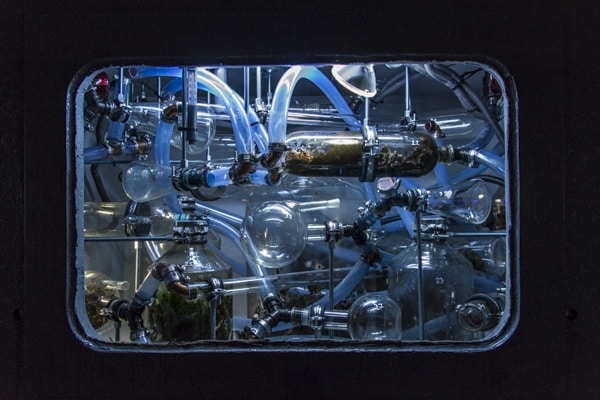
Jarosław Czarnecki (aka Elvin Flamingo), ‘The Symbiosity of Creation’, photo Contemporary Lynx, WRO Art Centre, part of The 16th Media Art Biennale WRO, Wrocław, 2015
The work ‘Symbiosity of Creation’ has received the Critics and Editors of Art Magazines Award (the editorial team of Contemporary Lynx was invited to be part of the jury). What moved the jurors was the consistency and perseverance in the artist’s activities, the concept of work-in-process, brave experimentation, cooperation with nature and learning from such intelligent organisms and communities as ant colonies. The jurors’ discussions, which yielded an indefinite number of interpretations reflected the work’s ability to go beyond the framework of simple classifications on the one hand, and its universality on the other.
There are absolutely no compromises in what we create together, and each of us—the superorganisms and me—mean nothing on our own; we don’t exist without one another as a work of art. We have found the shared quotidian that we create together. – states the artist, Elvin Flamino.

Jarosław Czarnecki (aka Elvin Flamingo), ‘The Symbiosity of Creation’, photo Contemporary Lynx, WRO Art Centre, part of The 16th Media Art Biennale WRO, Wrocław, 2015
Electronics, crowdsourcing and coincidence
Similarly, symbiosis of action was present in the 56 Broken Kindle Screens project by Sebastian Schmieg (Germany) and Silvio Lorusso (Italy). This inconspicuous work consisted of a broken Kindle e-book reader, and a tiny book of the same size. The book included photographs of cracked and broken Kindle screens. These broken screens created surprisingly interesting compositions by erroneously displaying overlapping pages and covers of e-books. This way, broken Kindle readers spontaneously and unintentionally form time-frozen psychedelic portraits, surreal collages or minimalistic abstractions. The artists used photos of screens posted online by a community of Kindle users. This simple work touched upon a plethora of important issues such as the place of technology in art (and in a broader sense electronics devoid of its original, utilitarian function), the role of coincidence, crowdsourcing, and intellectual property including the use of elements found on the internet. Irrespective of these big topics, it must be said that screens of broken Kindle readers are simply beautiful.
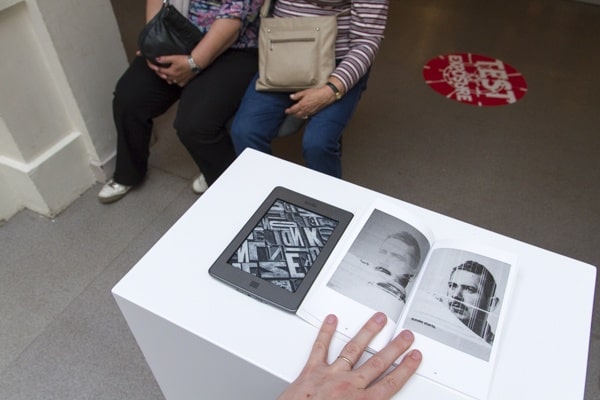
Sebastian Schmieg (Germany) and Silvio Lorusso (Italy), ’56 Broken Kindle’, photo Contemporary Lynx, National Museum, part of The 16th Media Art Biennale WRO, Wrocław, 2015
Art and social media
As part of the WRO festival, new media art was often presented in unorthodox spaces. Surprising locations gave artworks new meaning and injected surprise and intrigue among the viewers. The Renoma department store was one such space – a modern shopping centre where you can find every high-street brand. At the reception there were maps indicating the locations of art works: for example by the main entrance or hanging above one of the main passages. But artworks were also lurking in completely surprising places – one of the works was exhibited at the parking lot among cars. A work by Vincent Voillat from France entitled ‘Tapis Roulants/Rolling Carpets’ is an installation made of three car-shaped covers-carpets. The fabric lifted by hot air rose rhythmically giving the impression that these imaginary cars breathe in sleep. The recorded sounds of bustling street life enhanced the impression of movement and dynamics in contrast to these sleeping cars. These sounds had been recorded by the artist in the streets of Cairo. The location of this work next to the exit from the car park ensured drivers on their way to their cars looked in surprise at these car-like carpets. This gave the artwork a social media, flashmob flavour aimed at surprising or cheering up drivers passing by. References to Cairo have brought to mind the role of surprise and social media in recent pro-democratic protests in the Arab world, shaking people out of the somnambulism of daily life, thus giving Voillat’s work a political dimension.
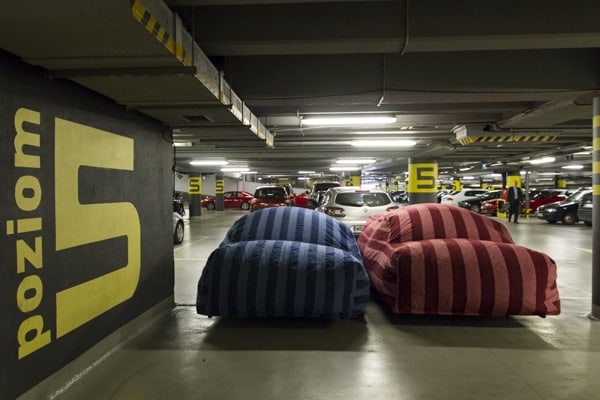
Vincent Voillat (France), ‘Tapis Roulants/Rolling Carpets’, photo Contemporary Lynx, Renoma Department Store, part of The 16th Media Art Biennale WRO, Wrocław, 2015
WRO in the past
WRO biennale has its long tradition. It has been organised since 1989 under the management of charismatic Piotr Krajewski. The first edition was entitled Sound Basic Art Festival, when Poland was a completely different place. At the time Poland was going through a major transformation and the WRO Festival constituted one of the first significant manifestation of new media art in Eastern Europe. Relations of visual art with music and experiments with art created in situ, performance and new media (tape recorders and adapters at the time) have a long tradition in Poland. Since the 60s, post-Stalinist thaw provided the artists with the possibility to experiment with sound, image, synthesizers, tapes. Artists went beyond visual arts by including music in their works. It is worth noting that performances and installations were created in Poland parallel to experimental works from the USA and Western Europe.

The 16th Media Art Biennale WRO, ‘Test Exposure’, outside the New Building of Wrocław University Library, photo Contemporary Lynx, Wrocław, 2015
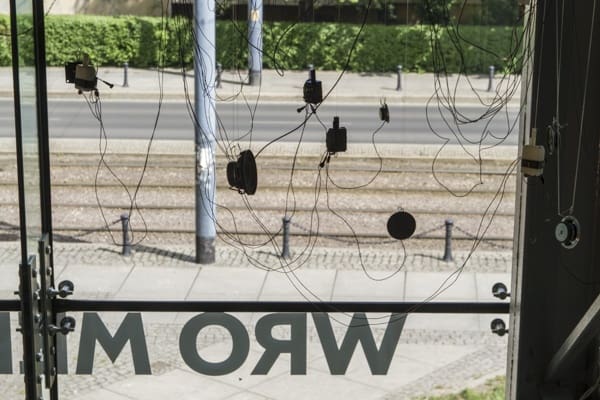
WRO Art Centre, photo Contemporary Lynx, The 16th Media Art Biennale WRO, Wrocław, 2015
WRO on the move
Today WRO Media Art Biennale is a significant event in the world of new media art. The works of artists from countries as far as Japan and Australia prove the festival’s international character. Importantly, WRO remains open to a wide range of artists and diverse audiences. A busy programme of events accompanies the main exhibitions. In short, WRO is a dynamic and thriving festival. As the artistic director Piotr Krajewski remarked: The motto ‘Test exposure’ stresses the fact that everything is on the move, art is on the move, reality lies in the movement […]. This movement needs to be tested. The WRO’s works enter new spaces and invite the viewer to join. They invite viewers to test and take a stance. This is what art is all about, a way to get to know a different world.
Finally, it is worth noting that in 2016, for a year, Wrocław will become the European Capital of Culture. To mark the occasion, the organisers of WRO will prepare a special edition of the Biennale. We can’t wait.
written by Sylwia Krasoń
translated by Monika Mokrosz

Marta Mielcarek (PL), Inversion, two-channel video installation First Best Media Art Diploma Work Competition Award (ex aequo), The 16th Media Art Biennale WRO, Wrocław, 2015
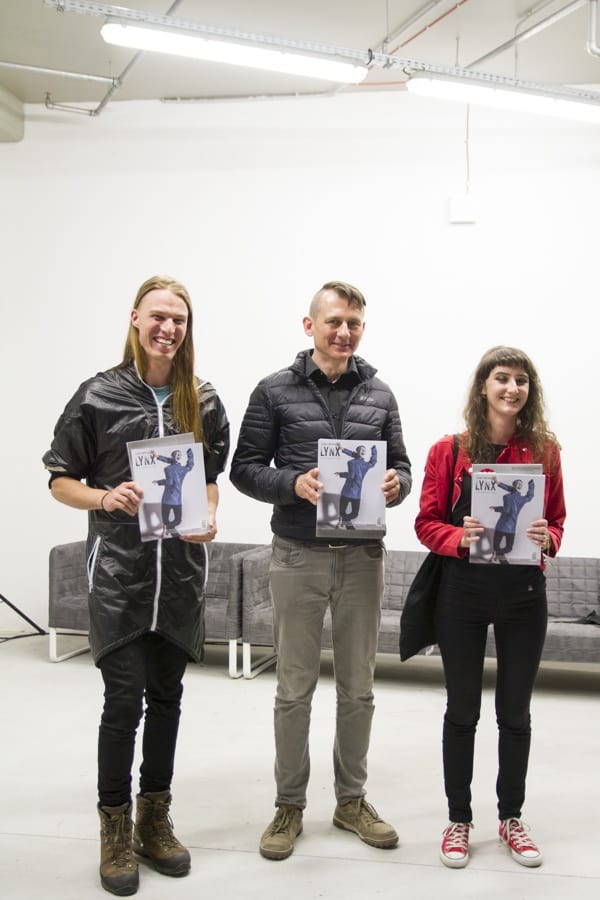
left: Michael Candy (AU), Jarosław Czarnecki aka Elvin Flamingo (PL) and Agata Kus (PL), WRO 2015 TEST EXPOSURE awards winners, photo Contemporary Lynx, 2015

The Critics and Editors of Art Magazines Award, the winner is Jarosław Czarnecki aka Elvin Flamingo (PL), The Symbiosity of Creation installation, photo Contemporary Lynx, Wrocław 2015
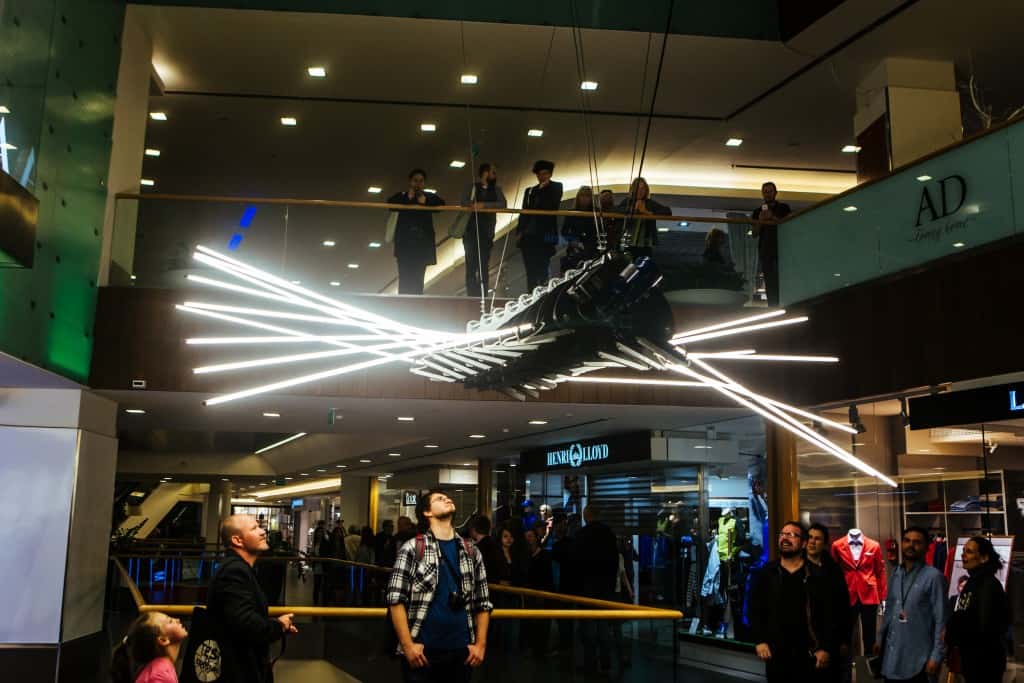
Michael Candy (AU), ‘Big Dipper’, kinetic-light sculpture, 2014 WRO 2015 Award (ex aequo), photo courtesy of the organisers, The 16th Media Art Biennale WRO, Wrocław, 2015
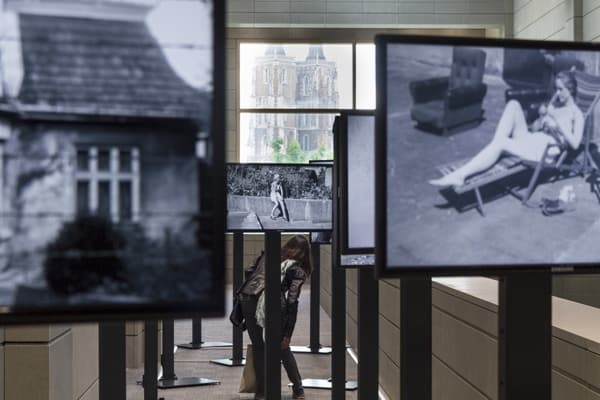
Agata Kus (PL), Mistress, multi-channel video installation, 2014, photo Contemporary Lynx, The 16th Media Art Biennale WRO, Wrocław, 2015

Exhibition view, National Museum in Wrocław, photo Contemporary Lynx, The 16th Media Art Biennale WRO, Wrocław, 2015
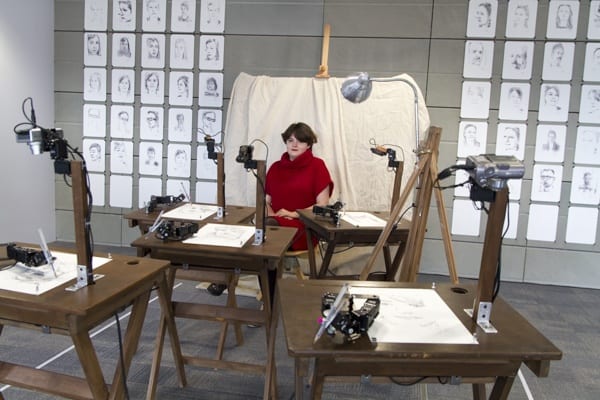
Patrick Tresset (FR/UK), 5 Robots named Paul, (5RNP) robotic instalation, photo Contemporary Lynx, The 16th Media Art Biennale WRO, Wrocław, 2015
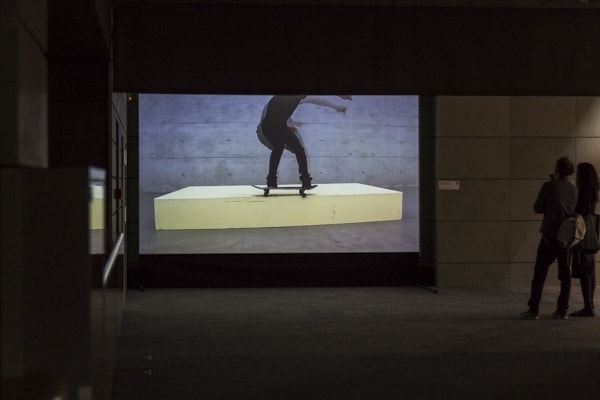
Kay Walkowiak (AT), Minimal Vandalism, video, 2013, 3:49, photo Contemporary Lynx, The 16th Media Art Biennale WRO, Wrocław, 2015
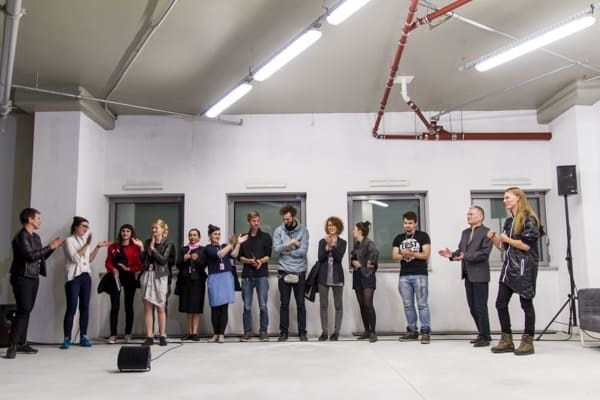
Award winners and organisers, The 16th Media Art Biennale WRO, Wrocław, 2015
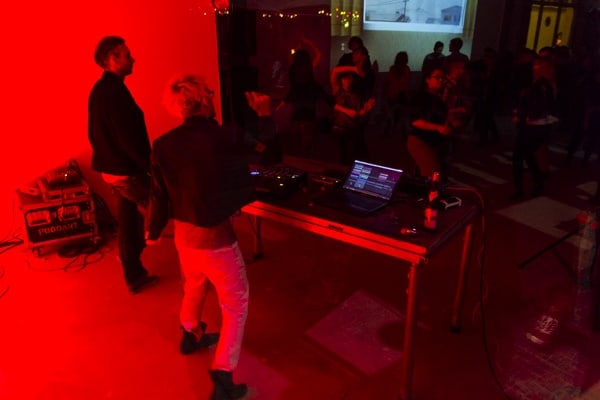
The 16th Media Art Biennale WRO, Wrocław, 2015, photo Contemporary Lynx
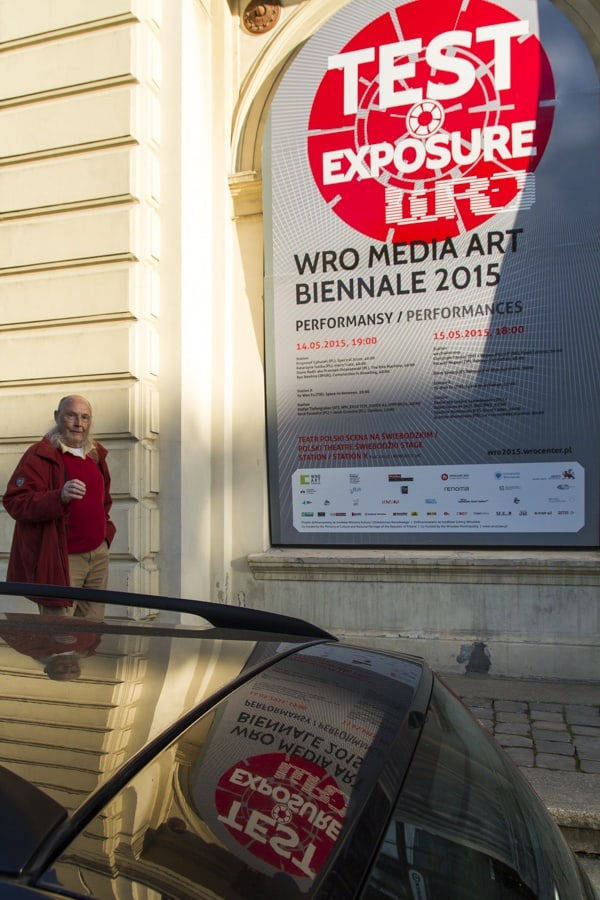
The 16th Media Art Biennale WRO, Wrocław, 2015, photo Contemporary Lynx








